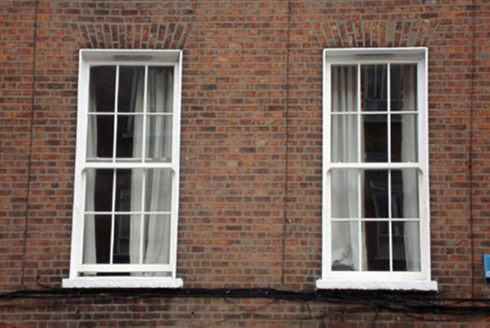Survey Data
Reg No
50010865
Rating
Regional
Categories of Special Interest
Architectural, Artistic
Original Use
House
In Use As
Apartment/flat (converted)
Date
1780 - 1800
Coordinates
315881, 235396
Date Recorded
10/10/2011
Date Updated
--/--/--
Description
Terraced four-storey house over exposed basement, built c.1790, having three-bay ground floor and two-bay first floor. Now in multiple occupancy. M-profile pitched roof with shared cement rendered chimneystack on party wall with No. 8 to west and single chimneystack on party wall with No. 10 to east. Red brick walls laid in Flemish bond to ground, first and second floors, early replacement red brick to lower half of third floor and later replacement red brick to upper section with granite-capped parapet. Ruled-and-lined rendered basement below painted granite plinth course. Gauged brick square-headed window openings with painted patent reveals and painted granite sills with replacement timber sliding sash windows throughout, three-over-three pane to top floor and six-over-six pane elsewhere, those to basement having steel guard bars. Mainly six-over-six pane timber sliding sash windows to rear, with two round-headed windows to stairs, and with replacement uPVC widows to top floor. Gauged brick round-headed door opening with painted stone door surround having cove scalloped archivolt. Engaged Ionic columns flanked by responding pilasters enclosing blocked up narrow sidelights. Stepped lintel and cornice with cornice enriched with paterae and fluting with plain fanlight. Ten-panel 'Dublin' door opens onto granite platform and three round-nosed granite steps bridging basement and flanked by painted wrought-iron railings on moulded painted granite plinth wall returning to west to enclose basement area, having matching gate. Basement area accessed by replacement steel steps and separated from No. 10 to west by granite-capped masonry wall. Concrete paved path with granite kerbing, two coal hole covers set in granite slabs, and decorative lamp post to east of building.
Appraisal
No. 9 forms part of a terrace of Georgian townhouses on the north side of Gardiner Place. It is a well presented and well proportioned middle-size Georgian house which plays an important role in the intact appearance of this fine streetscape, with its long vista towards Findlater's Church. The narrow, paired windows at ground floor level add interest and variety to the terrace and the fine classical doorcase provides a decorative focus. The retention of timber sash windows contributes to the historic architectural character of the building. The retention of the granite entrance landing and steps, and of the stone plinth wall and iron railings and gate to the basement area completes the setting. The house is a significant component in an important Georgian terrace and the whole contributes to the strong historic architectural character of this district. Gardiner Place was developed by Luke Gardiner II, in c.1790, as an extension of Gardiner's Row in order to link Rutland Square (Parnell Square) with the new and fashionable Mountjoy Square. Although built as a residential street, Gardiner Place was largely inhabited by legal professionals and doctors in the mid-nineteenth century, and as tenements, social housing and guest housing in the twentieth century.



















